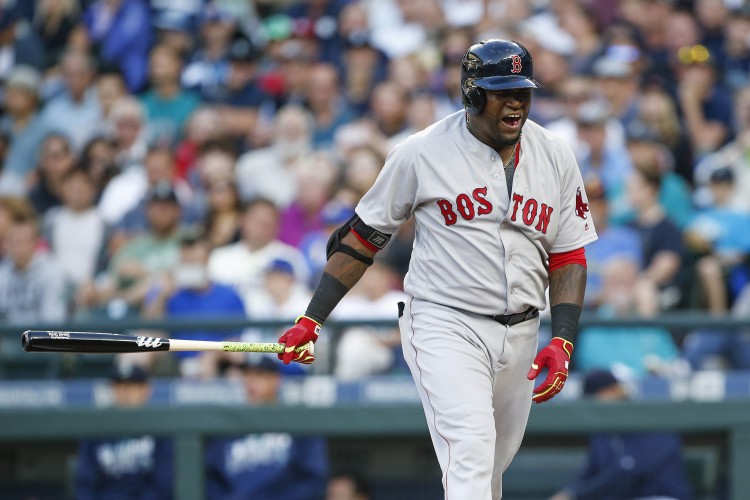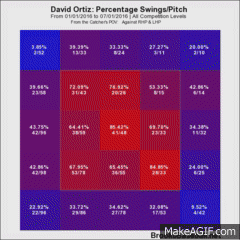Editor’s Note: The numbers in this post are through Tuesday’s action.
David Ortiz is having an incredible season in his final go-around the league. As someone who presumably follows the Red Sox — or at least baseball in general — I know this will come as a shock. Nobody is talking about this.
In addition to being the best hitter in arguably the league’s best lineup, he’s been the best hitter on the whole damn planet for essentially the entire season. That’s wild! There’s even been talk of him being an MVP candidate, and while that is an unlikely outcome, it also isn’t totally crazy. That alone is absurd for a 40 year old designated hitter. Through the first half of the season, everything was coming up Milhouse for Ortiz’s final season.
Unfortunately, a weird thing is happening lately: The slugger has been in the midst of an extended slump. Now, the only way to talk about slumps like this is using arbitrary endpoints. There’s no avoiding it! Half-season splits are far from perfect, but there’s no denying that Ortiz hasn’t been the same since the All-Star break. We’re only talking about 87 plate appearances, but he’s hitting just .221/.287/.364 in the second half. Really, though, you could extend this all the way back to July 2.
Remember those arbitrary endpoints I mentioned? This is an even more extreme example, because this is the day after Ortiz went 3-for-4 with a home run. Still, in the time since that game he’s gone 122 plate appearances with a .226/.303/.443 line. Not great, at least by his standards.
He’s still had good games in this span, and he almost certainly is still a great hitter. On the other hand, he is 40 years old, and age is a fickle beast.
Now, I’m not going to sit here and suggest that something happened on that day and a switch flipped. Baseball doesn’t work like that. He’s still had good games in this span, and he almost certainly is still a great hitter. On the other hand, he is 40 years old, and age is a fickle beast. He’s also been hurt the entire season, which is noticeable any time he has to run the bases. Hell, Steven Wright pinch ran for Ortiz the other day (and, of course, got injured in the process).
So, there are tangible reasons why he could be a lesser version of himself, continuing a downward trend we’ve seen for a month now. I wanted to see if there were any warning signs that this was the case rather than this just being a slump that we’ll all forget about when he puts up a 1.100 OPS in September and leads the Red Sox through another deep playoff run.
The first thing I wanted to look at was whether opposing pitchers have approached him differently, and it turns out they have. Pitchers have been serving Ortiz more fastballs during this post-July 1 stretch than they had in the first part of the season. It’s not a drastic increase, but there has been a four percentage point increase on hard pitches against the DH.
On the one hand, this is a crazy development, as you don’t typically want to serve up a bunch of fastballs to a slugger of Ortiz’s caliber. On the other hand, aging players start to have trouble catching up to velocity, and maybe pitchers want to test that here. If they are taking that test, they are failing. Per Brooks Baseball, Ortiz is actually whiffing less against these hard pitches, and he’s hitting just as many line drives as he did during the first portion of the season. So, that eliminates that theory.
One change that is happening, though, is that he hasn’t been using the most advantageous portions of the field. We’ve seen his power numbers drop — .349 ISO in the first half vs. .143 in the second — and part of the reason could be that he’s not using the power alleys as much. To the spray chart!
As you can see, there is a whole lot of blank space in the gaps, particular in left-center field. Essentially, everything being hit towards the middle is going right through the middle of the field. Now, to be fair, this certainly seems like bad luck and something that should even out over time. It also seems like it would have an effect on those power numbers, both by cutting down his HR/FB ratio (it’s harder to hit home runs when you’re constantly hitting it to the deepest part of the field) and his doubles (many doubles are hit in the gaps).
The biggest change for Ortiz during this rough stretch, though, is his plate discipline. Now, he hasn’t turned into Mark Trumbo or anything, but he’s watched his walk rate fall by nearly five percentage points since the All-Star Break to a merely good 9.2 percent. The issue here is simple: He’s swinging at more balls off the plate.
As you can see, the real problem is that Ortiz has been more aggressive lately on pitches in on his hands and below the zone. The thing is, he’s not whiffing on these pitches — which is why we haven’t really seen an increase in strikeout rate — but that could be just as bad. By putting these balls in play, he’s making a lot more weak contact, and Ortiz certainly isn’t going to beat out any groundballs in the infield. So, this trend is hurting both his walk numbers and his power numbers.
Overall, though, it seems like there is nothing major to worry about with Ortiz. It was and is fair to worry about any 40-year-old during a slump, but he’s not really struggling against velocity, which could be the number one indicator of decline. With that said, there are some plate discipline concerns, but given the sample size it’s reasonable to believe someone of his caliber will turn things around. Most of the other downfalls point to rough luck. Ortiz hasn’t been himself for the last month, but there’s still every reason to believe he’ll retire as the same quality of hitter we’ve grown accustomed to.
Photo by Joe Nicholson/USA TODAY


